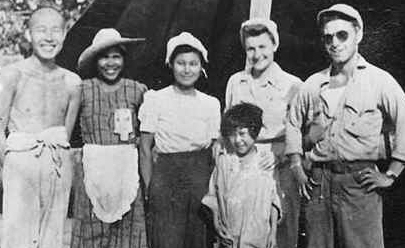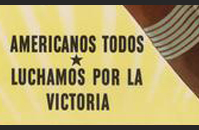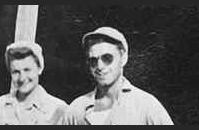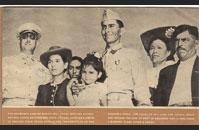LATINO AMERICANS IN WWII AT A GLANCE:

Image Gallery
Los Veteranos: Latino Americans in WWII
Over 500,000 Latinos (including 350,000 Mexican Americans and 53,000 Puerto Ricans) served in WWII. Exact numbers are difficult because, with the exception of the 65th Infantry Regiment from Puerto Rico, Latinos were not segregated into separate units, as African Americans were. When war was declared on December 8, 1941, thousands of Latinos were among those that rushed to enlist. Latinos served with distinction throughout Europe, in the Pacific Theater, North Africa, the Aleutians and the Mediterranean. Among other honors earned, thirteen Medals of Honor were awarded to Latinos for service during WWII.
In the Pacific Theater, the 158th Regimental Combat Team, of which a large percentage was Latino and Native American, fought in New Guinea and the Philippines. They so impressed General MacArthur that he called them “the greatest fighting combat team ever deployed in battle.” Latino soldiers were of particular aid in the defense of the Philippines. Their fluency in Spanish was invaluable when serving with Spanish speaking Filipinos. These same soldiers were part of the infamous “Bataan Death March.” On Saipan, Marine PFC Guy Gabaldon, a Mexican-American from East Los Angeles who had learned Japanese in his ethnically diverse neighborhood, captured 1,500 Japanese soldiers, earning him the nickname, the “Pied Piper of Saipan.”
In the European Theater, Latino soldiers from the 36th Infantry Division from Texas were among the first soldiers to land on Italian soil and suffered heavy casualties crossing the Rapido River at Cassino. The 88th Infantry Division (with draftees from Southwestern states) was ranked in the top 10 for combat effectiveness.
Latino Women and WWII
Latinas served during WWII despite cultural barriers that had in the past prevented them from leaving their families and traveling long distances alone. Bilingualism was highly sought after during the war and so they found important work in cryptology, communications and interpretation. As linguists, nurses and Red Cross aids, and in the WAACS, WAVES, and Marine Corps Women’s Reserve, Latinas broke through both gender and cultural barriers to serve their country.
On the Home Front
Thousands of Latino men and women on the Home Front worked on railroads, in mines, shipyard and airplane factories and as crucial agricultural labor. A shortage of manual labor jeopardized the war effort, so the US government established the Bracero Program, allowing 50,000 Mexican agricultural workers and 75,000 railroad workers to come as guest workers to the United States. These workers were crucial to the country’s wartime economy.
Zoot Suit Riots
During the 1930s and 40s, many Latino youths in the Southwestern U.S. developed their own sub-culture, which included distinctive fashions, music, and slang. These youths, rebelling both against Anglo culture and even against elements of their own culture, called themselves Pachucos. To the White community, Pachuco culture soon became synonymous with gang culture, and social tensions threatened to erupt in several urban areas. On the night of June 3, 1943, eleven U.S. Navy sailors on shore leave in Los Angeles claimed they were attacked by a “group of Mexican kids.” Soon after scores of sailors and Marines invaded the Latino community of East Los Angeles, targeting anyone they saw wearing a “zoot suit,” a Pachuco style of clothing, featuring a long dress coat with baggy pants. The riots continued for another two nights and the sailors and Marines were portrayed in the press as heroes suppressing a “Mexican crime wave.” In some cases, police actually accompanied sailors and Marines and then arrested their beaten victims.
After the War
Latinos felt their efforts and sacrifices during the war had earned them equal rights. But, Latinos, like other minority groups in the United States, faced discrimination when they returned from war. Many future leaders of the Latino and Chicano Civil Rights Movements began their efforts after having served in uniform. Most prominent among these was Dr. Hector Garcia, founder of the American G.I. Forum, a civil rights group still active today fighting for Latino rights in health care, education, labor agreements, and the court system.
Download a printable version of this At A Glance
TAKE ACTION:


EDUCATION PROJECTS:
Student Travel – WWII Educational Tours
High school and college students, learn the leadership principles that helped win WWII on a trip to France or during a weeklong residential program in New Orleans. College credit is available, and space is limited.
See You Next Year! HS Yearbooks from WWII
Collected from across the United States, the words and pictures of these yearbooks present a new opportunity to experience the many challenges, setbacks and triumphs of the war through the eyes of America’s youth.
The Victory Gardens of WWII
Visit the Classroom Victory Garden Project website to learn about food production during WWII, find lesson plans and activities for elementary students, get tips for starting your own garden and try out simple Victory Garden recipes!
The Science and Technology of WWII
Visit our new interactive website to learn about wartime technical and scientific advances that forever changed our world. Incorporates STEM principles to use in the classroom.
Kids Corner: Fun and Games!
Make your own propaganda posters, test your memory, solve puzzles and more! Learn about World War II and have fun at the same time.






